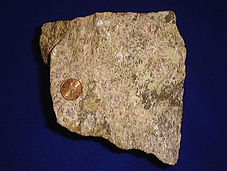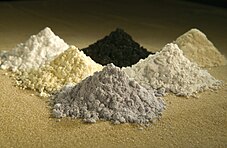
A | B | C | D | E | F | G | H | CH | I | J | K | L | M | N | O | P | Q | R | S | T | U | V | W | X | Y | Z | 0 | 1 | 2 | 3 | 4 | 5 | 6 | 7 | 8 | 9
The rare-earth elements (REE), also called the rare-earth metals or rare earths or, in context, rare-earth oxides, and sometimes the lanthanides (although scandium and yttrium, which do not belong to this series, are usually included as rare earths),[1] are a set of 17 nearly indistinguishable lustrous silvery-white soft heavy metals. Compounds containing rare earths have diverse applications in electrical and electronic components, lasers, glass, magnetic materials, and industrial processes.
Scandium and yttrium are considered rare-earth elements because they tend to occur in the same ore deposits as the lanthanides and exhibit similar chemical properties, but have different electrical and magnetic properties.[2][3] The term 'rare-earth' is a misnomer because they are not actually scarce, although historically it took a long time to isolate these elements.[4][5]
These metals tarnish slowly in air at room temperature and react slowly with cold water to form hydroxides, liberating hydrogen. They react with steam to form oxides and ignite spontaneously at a temperature of 400 °C (752 °F). These elements and their compounds have no biological function other than in several specialized enzymes, such as in lanthanide-dependent methanol dehydrogenases in bacteria.[6] The water-soluble compounds are mildly to moderately toxic, but the insoluble ones are not.[7] All isotopes of promethium are radioactive, and it does not occur naturally in the earth's crust, except for a trace amount generated by spontaneous fission of uranium-238. They are often found in minerals with thorium, and less commonly uranium.
Though rare-earth elements are technically relatively plentiful in the entire Earth's crust (cerium being the 25th-most-abundant element at 68 parts per million, more abundant than copper), in practice this is spread thin across trace impurities, so to obtain rare earths at usable purity requires processing enormous amounts of raw ore at great expense, thus the name "rare" earths.
Because of their geochemical properties, rare-earth elements are typically dispersed and not often found concentrated in rare-earth minerals. Consequently, economically exploitable ore deposits are sparse.[8] The first rare-earth mineral discovered (1787) was gadolinite, a black mineral composed of cerium, yttrium, iron, silicon, and other elements. This mineral was extracted from a mine in the village of Ytterby in Sweden; four of the rare-earth elements bear names derived from this single location.
Minerals
A table listing the 17 rare-earth elements, their atomic number and symbol, the etymology of their names, and their main uses (see also Applications of lanthanides) is provided here. Some of the rare-earth elements are named after the scientists who discovered them, or elucidated their elemental properties, and some after the geographical locations where discovered.
| Z | Symbol | Name | Etymology | Selected applications | Abundance[9][10] (ppm[a]) |
|---|---|---|---|---|---|
| 21 | Sc | Scandium | from Latin Scandia (Scandinavia). | Light aluminium-scandium alloys for aerospace components, additive in metal-halide lamps and mercury-vapor lamps,[11] radioactive tracing agent in oil refineries | 22 |
| 39 | Y | Yttrium | after the village of Ytterby, Sweden, where the first rare-earth ore was discovered. | Yttrium aluminium garnet (YAG) laser, yttrium vanadate (YVO4) as host for europium in television red phosphor, YBCO high-temperature superconductors, yttria-stabilized zirconia (YSZ) (used in tooth crowns; as refractory material - in metal alloys used in jet engines, and coatings of engines and industrial gas turbines; electroceramics - for measuring oxygen and pH of hot water solutions, i.e. in fuel cells; ceramic electrolyte - used in solid oxide fuel cell; jewelry - for its hardness and optical properties; do-it-yourself high temperature ceramics and cements based on water), yttrium iron garnet (YIG) microwave filters,[11] energy-efficient light bulbs (part of triphosphor white phosphor coating in fluorescent tubes, CFLs and CCFLs, and yellow phosphor coating in white LEDs),[12] spark plugs, gas mantles, additive to steel, aluminium and magnesium alloys, cancer treatments, camera and refractive telescope lenses (due to high refractive index and very low thermal expansion), battery cathodes (LYP) | 33 |
| 57 | La | Lanthanum | from the Greek "lanthanein", meaning to be hidden. | High refractive index and alkali-resistant glass, flint, hydrogen storage, battery-electrodes, camera and refractive telescope lenses, fluid catalytic cracking catalyst for oil refineries | 39 |
| 58 | Ce | Cerium | after the dwarf planet Ceres, named after the Roman goddess of agriculture. | Chemical oxidizing agent, polishing powder, yellow colors in glass and ceramics, catalyst for self-cleaning ovens, fluid catalytic cracking catalyst for oil refineries, ferrocerium flints for lighters, robust intrinsically hydrophobic coatings for turbine blades[13] | 66.5 |
| 59 | Pr | Praseodymium | from the Greek "prasios", meaning leek-green, and "didymos", meaning twin. | Rare-earth magnets, lasers, core material for carbon arc lighting, colorant in glasses and enamels, additive in didymium glass used in welding goggles,[11] ferrocerium firesteel (flint) products, single-mode fiber optical amplifiers (as a dopant of fluoride glass) | 9.2 |
| 60 | Nd | Neodymium | from the Greek "neos", meaning new, and "didymos", meaning twin. | Rare-earth magnets, lasers, violet colors in glass and ceramics, didymium glass, ceramic capacitors, electric motors in electric automobiles | 41.5 |
| 61 | Pm | Promethium | after the Titan Prometheus, who brought fire to mortals. | Nuclear batteries, luminous paint | 1×10−15[14][b] |
| 62 | Sm | Samarium | after mine official, Vasili Samarsky-Bykhovets. | Rare-earth magnets, lasers, neutron capture, masers, control rods of nuclear reactors | 7.05 |
| 63 | Eu | Europium | Zdroj:https://en.wikipedia.org?pojem=Rare_earth_elements


